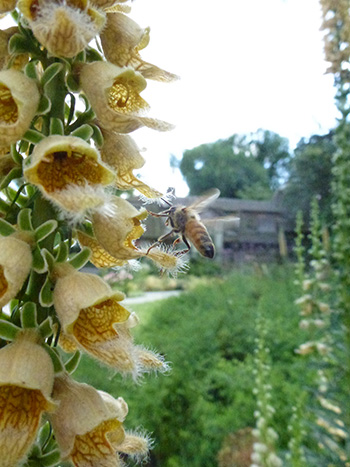
Plants of the Week: July 10
Digitalis ferruginea
As I walk around the Scott Arboretum in the summer I am always drawn to big hubs of pollination. The rusty foxglove patch in the Scott Entrance Garden is one of these hubs.
Both the common and latin names stem from the particularly rusty color of the flowers of ferruginea. D. ferruginea puts up tall spikes of flowers about the beginning of June and they are visited heavily by honey bees. They also attract hummingbirds. The flower spikes make good additions to cut flower arrangements.
D. ferruginea naturally grows as a biennial, overwintering its first year with a single basal rosette of evergreen leaves. However, foxglove is such a good self-seeder that once you plant it, your garden will have it for many years. Another strategy for foxglove is to train it as a perennial by cutting back the flower spike before it goes to seed in early autumn.
D. ferruginea likes partial shade and very moist soil, and is fairly tolerant of disease and pests. Rusty foxglove looks very at home in a naturalized garden setting. Alternatively, the tall flower spikes can add contrast to tall sculptures and walls. Photo credit: G. Wermeling
Lavandula x intermedia ‘Phenomenal’
Continuing my walk I head to the Dean Bond Rose Garden to look for pollinator systems and I am not disappointed. The lavender is in full bloom and is absolutely covered with honey bees.
The plant gives off a strong, identifying fragrance. Its tall spikes of flowers could easily be combined with rusty foxglove flowers in arrangements. The plant is often used by growers to make oils. Beekeepers often grow lavender to support their farms. Lavender plants have been prized by humans for thousands of years; the bible mentions lavender by its ancient greek name, nard.
Most accounts of this cultivar of lavender are so enthusiastic that the name ‘Phenomenal’ seems completely appropriate. It is deer, drought, and heat resistant; it needs full sun. There is almost no winter die-back, and the foliage remains year round.
The lavender plants in the rose garden have large, very even spreads radiating from a center. ‘Phenomenal’ can also be grown in containers to lend fragrance to a deck or patio. Photo credit: G. Wermeling
Nepenthes sp.
On my way back to the Wister Center, I noticed a slightly more one-sided plant-insect relationship hanging from the trellis in the Terry Shane Teaching Garden. It is a container of Nepenthes sp., also known as pitcher plants or monkey cups. These plants are carnivorous and use their pitchers to trap and digest any insect which slip in. The pitchers grow from extended leaf midribs, called tendrils.
Nepenthes species are generally very difficult to classify in the field because most mature species exhibit leaf dimorphism based on height. The pitchers at the base of the plant are larger and the pitchers at the top are smaller with tendrils more adapted for climbing. If kept in a basket like those at the Scott Arboretum the plants only grow their larger, lower pitchers.
Nepenthes are largely endemic to eastern hemisphere tropical montane regions such as Southern China, Malaysia, and the Philippines. They garnered the name monkey cups because monkeys are routinely seen drinking out of the cups.
Due to their mountainous growth habit Nepenthes tend to be happy with temperature ranges from 60-90 degrees. They are definitely summer plants and you will want to move them inside come winter.
Many pitcher plants have lids which remain upright, allowing the pitcher to fill with rainwater as the season progresses. While this does not adversely affect the plant in any way, you should be wary of mosquitoes, as they may lay their eggs in the still water of the pitchers.
Photo credit: G. Wermeling








No Comments